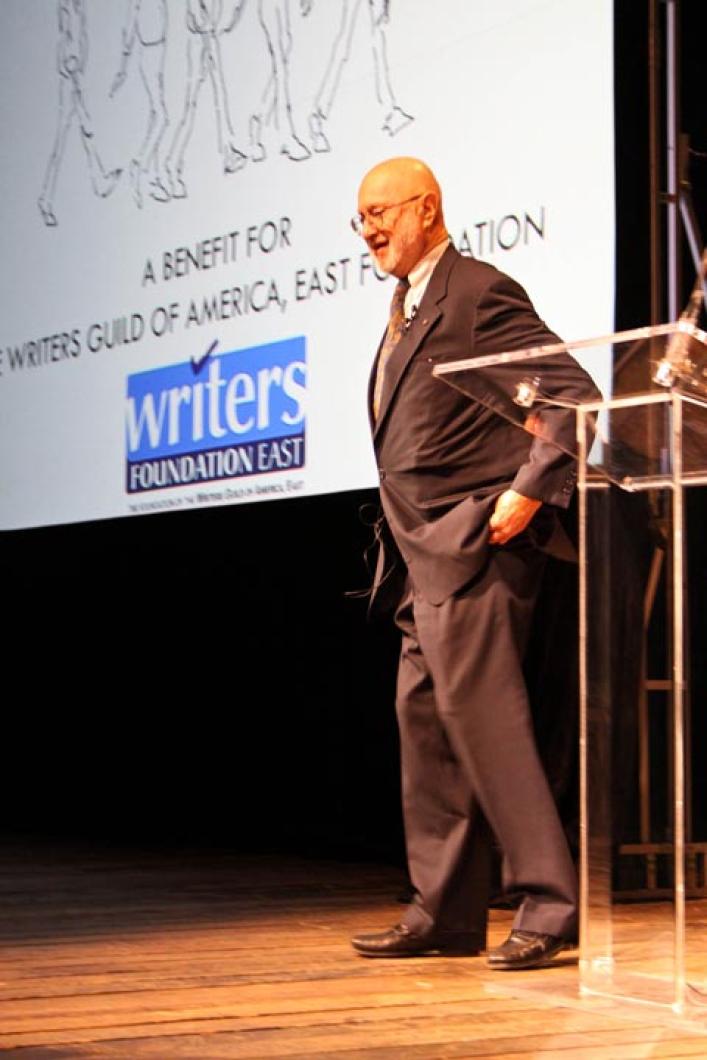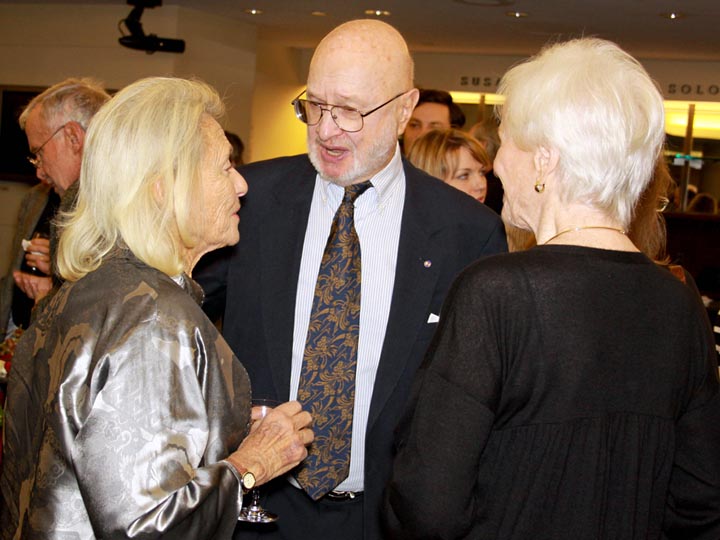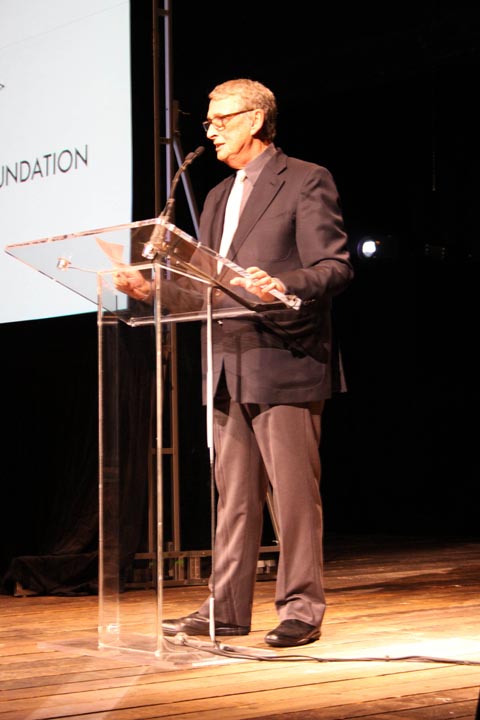Like an elongated dancer in one of his drawings, lanky Jules Feiffer loped in, stretched out his fingers and curtseyed to the standing ovation that greeted his arrival on the Broadway stage last Monday night. Knees bent, he cocked his head and lifted his eyebrows, simultaneously sheepish and soaking it all up.
As soon as the applause died, of course, he stuffed his hands in his suit pockets, shuffled off to the side and muttered into his microphone a warning to himself not to take a pratfall off the stage.
The man who began his career with A Guide to Non-Confident Living (that was the subtitle to his long-running Village Voice comic strip Sick Sick Sick) knows his schtick.
“Self-deprecation is a way that we show off,” he said, taking his central contradiction head-on as he settled in to give a benefit performance for the Writers Guild of America, East Foundation.
The trick is to make it seem effortless, easy, like Fred Astaire, who has been a lifelong inspiration for Mr. Feiffer’s pen, often drawn in his barn-like Vineyard studio. “Astaire always danced with a sense of, ‘Who, me?’”
And so began the purposefully non-bravura story of the bravura career of this cartoonist, playwright, screenwriter, children’s book illustrator, author and memoirist.
It was the first ever benefit for the foundation, which among other works offers writing mentoring to war veterans, some of whom attended.
The event brought together many strands of the life-in-progress that is Mr. Feiffer. There was his daughter Kate, with whom he has collaborated on children’s books; his daughter Halley, who was on a night off from appearing on stage herself in Tigers Be Still; his publisher Nan Talese and her husband, the legendary writer Gay Talese; John Lahr of The New Yorker; comedian Robert Klein, who marveled at how Mr. Feiffer managed to have “both an inferiority and a superiority complex at the same time.”
Mr. Feiffer’s sister Alice was there with her husband, Hal Korman, and she joked, “I can pinpoint exactly when Jules became famous: in 1955 he was my brother, and in 1956 I was Jules Feiffer’s sister, which I’ve been ever since.”
Susanna Styron, whose father, Bill, was part of Mr. Feiffer’s Vineyard circle, is on the board of the guild. She called the evening not just a performance by, but a tribute to, the artist. Her mother, Rose, and sister, Alexandra, attended, as did Vineyarders Mary Wallace and John and Goldie Siffert.
One of the most moving moments of the evening came from another familiar Island presence, Mike Nichols, who began, “A man who doesn’t have an enemy in the world, one who takes joy in the success of others . . . it would be so much easier if we were honoring a man like that.”
After the laughs, Mr. Nichols, who directed Mr. Feiffer’s screenplay Carnal Knowledge, said, “Truth is, working on a movie and three plays with Jules is as happy as I’ve ever been.”
He called Mr. Feiffer his oldest friend “in every way.” He shrugged as he said, “Talking about my love for Jules is as awkward as talking about my love for my wife, my children, my dog.” The filmmaker who two years ago had bypass surgery finished by telling his friend that he had, “one refurbished and strong heart that is yours forever.”
Mr. Feiffer too put his heart on his sleeve.
Another introduction had come from clowning legend Bill Irwin, who held up Mr. Feiffer’s book Backing Into Forward and said he went straight to “one of the darkest chapters . . . I don’t mean McCarthyism, I mean the making of Popeye.”
Though the film got decidedly mixed reviews, Mr. Feiffer said that the daughter of E.C. Segar, the author of the original Popeye strip, had called him up to say he was the first to ever capture her father’s voice in another form. “I hung up the phone and I cried,” said the 81-year-old.
He’s a man who reveres his predecessors. He tried to explain to the audience at the Samuel J. Friedman Theatre on West 47th street just how comics affected his childhood in the Bronx. Back then, he said, he would steal newspapers from the super. He would read them on all fours on the floor of the building. He would save them for years.
Remember, he said, there was no television, there was not yet color in the movies. “These color comics were movies on paper,” he said, and he wanted to make them.
“The only thing I lacked was facility,” he deadpanned. He claimed the only reason Will Eisner hired the 16-year-old Feiffer — who cold-called for a job in what he considered his calling — was “as a groupie.”
“But will can make up for a lot,” Mr. Feiffer said. And he has willed himself an incredible career, winning many awards, including a Pulitzer and an Obie and more, none of which he mentioned during his 90-minute performance.
This presentation, entitled Jules Feiffer: Funny Side Up, began with a short history of comics, including Mr. Feiffer’s first efforts ghostwriting Eisner’s Spirit and the first strip of his own, Clifford, but it concentrated heavily on the Village Voice years.
These were the neurotic, the political, the satirical, the unrelenting and groundbusting works that showed up just as Cold War America was showing its fissures.
The strip, eventually called Feiffer, was blown up in black and white behind him on stage (although he drew in color for other media, “I never felt the color was comfortable or necessary,” he said). He dissected his selection of cartoons aloud, giving voice to the appealing fragile lines on paper. He voiced, with surprising accuracy, Lyndon Johnson, Henry Kissinger, Sigmund Freud, Gandhi and others as they appeared in his drawn boxes. He kept the audience spellbound. In the dark, he was a man telling stories.
And that’s just what he was with his daughter, Julie, when he realized he could write children’s books. She demanded that he make up a story each night, which he did before promptly falling asleep himself, remembering nothing the next morning. However, the night he made up Bark, George — a story about a puppy who does not sound like a puppy no matter how his mother demands that he bark — he knew he had a good one, and forced himself up for long enough to jot down the idea. Just as well, he said, because in the morning he remembered nothing until he saw the notes that became one of his most beloved books.
Cartooning is solitary work. The fun of writing for the theatre, he recalled, was the collaboration. But he’d left playwrighting and never dreamed he would again find the fun of collaboration which he did in children’s books. He has drawn with his author daughter, Kate Feiffer, Henry the Dog with No Tail, Which Puppy? and another called My Side of the Car, which will be released next April.
He danced through them all before taking questions with the help of playwright Marsha (’Night Mother) Norman and actor Eric Bogosian. One questioner asked about his expertise in drawing hands and feet. “Astaire danced with his hands . . . good actors act with their feet . . . these add theatricality to the cartoon,” he said.
But when he’s drawing, he has no idea what his hands are doing, he said. “I’m not in control of it . . . when it’s really good I don’t know what I’m doing.”
Maybe that’s why he’s happy to be where he is now, where “I am more eager to learn now, I value stupidity more.” And with that, he stuffed his hands back into his pockets and nodded, sheepishly and soaking it all in, as the audience rose again in applause.








Comments
Comment policy »